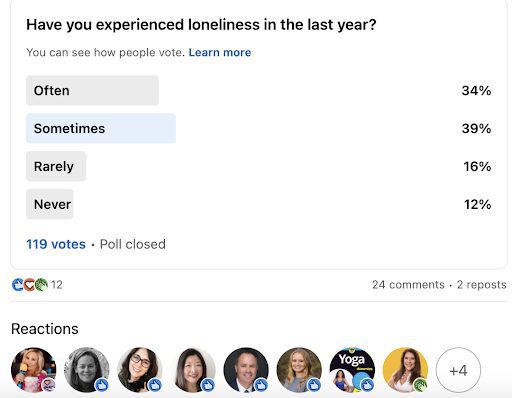In an age where technology aims to bring us closer, it’s ironic how many feel more isolated than ever. The ‘Loneliness Epidemic‘ is not just a buzzword; it’s a concerning reality affecting both our mental and physical health.
VIDEO INTERVIEW – Felena Hanson, founder of Hera Hub, talks about the loneliness epidemic with Mady Tyson, founder of the Hopeware Center.
This conversation was spurred by an episode of the Ezra Klein Podcast with author Sheila Liming, an associate professor of communications and creative media at Champlain College and the author of the new book “Hanging Out: The Radical Power of Killing Time.” In the book, Liming investigates what she calls the “quiet catastrophe” brewing in our social lives: the devastating fact that we’ve grown much less likely to simply spend time together outside our partnerships, workplaces and family units.
Loneliness: A Growing Concern
America’s loneliness stats are worrying. It’s impossible to deny that the U.S. has a serious loneliness problem. One 2018 report by the Kaiser Family Foundation found that 22 percent of all adults — almost 60 million Americans — said they often or always felt lonely or socially isolated. That was a full two years before the Covid pandemic. And Americans appear to be getting lonelier over time: From 1990 to 2021, there was a 25 percentage point decrease in the number of Americans who reported having five or more close friends. Young people now report feeling lonelier than the elderly.
Even with the rise of social media and instant messaging designed to foster bonds, real-world human interactions are on the decline. This leaves many feeling detached and alone, even when constantly connected online.
The Home-Office Hurdles
- The Blurred Lines: Long work hours, never-ending Zoom meetings, and juggling personal life with professional tasks make the work-from-home experience overwhelming for many.
- The Missing Human Touch: Remote work often means missing out on the crucial interactions essential for our wellbeing. Video calls just don’t replace the warmth and understanding of face-to-face meetings.
- Identity Boundaries: Dr. Gerada highlights the emotional challenges of professional tasks at home. The need for a distinct separation between professional and personal personas is more important than we realize.
- Mental Health Impacts: Dr. Stella Chan of the University of Reading points out that lack of motivation, a common symptom of depression, can be aggravated by continuous isolation. Engaging in activities outside one’s comfort zone can provide a sense of achievement, breaking the cycle of misery.
 “When we go to the office, or another place that isn’t our home, we change our mindset,” says one clinical neuropsychologist. “Our brain puts negative emotions that develop in one environment on pause when we move to another environment. By the time we are reminded of the difficult feelings later on, they are usually less upsetting because we’ve had some separation from them.”
“When we go to the office, or another place that isn’t our home, we change our mindset,” says one clinical neuropsychologist. “Our brain puts negative emotions that develop in one environment on pause when we move to another environment. By the time we are reminded of the difficult feelings later on, they are usually less upsetting because we’ve had some separation from them.”
We have important boundaries between home life and work life – and it’s those boundaries where we shift our identities. You need to be able to get home, take off your metaphorical white coat and take on a different persona, whether that is mother, girlfriend, husband, wife, whatever.
It’s Not Just Technology; It’s Our Choices
While it’s easy to blame technology, the rise in loneliness is also a reflection of the societal structures we’ve created. We might be more connected, but not necessarily in ways that fulfill our intrinsic social needs.
The Human Touch in a Digital World
We’re inherently social beings. Our brains are wired for in-person interactions, understanding non-verbal cues, and forming deep emotional bonds. Studies consistently show the mental health benefits of real-world interactions over virtual ones.
Coworking: The Social Solution
So, how can we redesign our environment to nurture genuine connections? Coworking spaces have risen as beacons of hope. They’re not just an alternative to traditional office setups; they’re cultivating genuine communities among freelancers, entrepreneurs, and remote workers. They offer a perfect blend of professional ambiance with a community feel. If you’re feeling the weight of isolation, perhaps it’s time to explore coworking and rediscover the joys of social connectivity.
Get out and join a coworking space today!
Felena Hanson conducted a poll on LinkedIn to get feedback from her community. Here are the findings.






